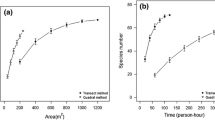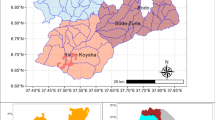Abstract
Tardigrade communities are affected by micro and macro-environmental conditions but only micro-environmental variables, and altitudinal gradients have been studied. We review previous reports of altitudinal effects and evaluate the influence by interacting macro- (climate, soils, biome, and others) and micro-environmental (vegetation, moss and leaf litter) factors on tardigrade assemblages at the Sierra de Guadarrama mountain range (Iberian Central System Mountains, Spain). Terrestrial tardigrade assemblages were sampled using standard cores to collect leaf litter and mosses growing on rocks. General Linear Models were used to examine relationships between Tardigrada species richness and abundance, and macro- and micro-environmental variables (altitude, habitat characteristics, local habitat structure and dominant leaf litter type, and two bioclimatic classifications). Variation partitioning techniques were used to separate the effects of altitude and habitat variation, and to quantify the independent influences of climate and soil, vegetation structure and dominant type of leaf litter. Altitude shows a unimodal relationship with tardigrade species richness, although its effect independent of habitat variation is negligible. The best predictors for species richness were bioclimatic classifications. Separate and combined effects of macro-environmental gradients (soil and climate), vegetation structure and leaf litter type are important determinants of richness. A model including both macro- and micro-environmental variables explained nearly 60% of tardigrade species richness in micro-scale plots. Abundance was significantly related only to soil composition and leaf litter type. Tardigrade abundance was not explained by macro-environmental gradients analysed here, despite a significant correlation between abundance and richness.





Similar content being viewed by others
References
Allué Andrade JL (1990) Atlas Fitoclimático de España. Taxonomías. Ministerio de Agricultura, Pesca y Alimentación. Instituto Nacional de Investigaciones Agrarias, Madrid
Austin MP, Pausas JG, Nicholls AO (1996) Patterns of tree species richness in relation to environment in southeastern New South Wales, Australia. Aust J Ecol 21:154–164. doi:10.1111/j.1442-9993.1996.tb00596.x
Baas-Becking LGM (1934) Geobiologie of inleiding tot de milieukunde. W.P. van Stockum and Zoon, The Hague
Bartǒs E (1939) Die Tardigraden der Tschechoslowa kischen Republik. Zool Anz 125:138–142
Beasley CW (1988) Altitudinal distribution of Tardigrada of New Mexico with the description of a new species. Am Midl Nat 120:436–440. doi:10.2307/2426016
Bertrand M (1975) Répartition des tardigrades “terrestres” dans le massif de L’Aigoual. Vie milieu C Biol Te XXV: 283–298
Borcard D, Legendre P, Drapeau P (1992) Partialling out the spatial component of ecological variation. Ecology 73:1045–1055. doi:10.2307/1940179
Catterall CP, Piper SD, Bunn SE, Arthur JM (2001) Flora and fauna assemblages vary with local topography in a subtropical eucalypt forest. Austral Ecol 26:56–69. doi:10.1046/j.1442-9993.2001.01074.x
Chefaoui RM, Hortal J, Lobo JM (2005) Potential distribution modelling, niche characterization and conservation status assessment using GIS tools: a case study of Iberian Copris species. Biol Conserv 122:327–338. doi:10.1016/j.biocon.2004.08.005
Clark Labs (2000) Global change data archive: 1 km global elevation model, vol 3. CD-Rom, Clark University
Clark Labs (2001) Idrisi 32 Release 2. GIS software package. Clark Labs, Worcester, MA
Collins M, Bateman L (2001) The ecological distribution of tardigrades in Newfoundland. Zool Anz 240:291–297. doi:10.1078/0044-5231-00036
Crawley MJ (1993) GLIM for Ecologists. Blackwell Scientific Publications
Dastych H (1980) Macrobiotus kurasi sp. nov., a new specie of Tardigrada from Mountains of Uganda. B Acad Pol Sci Biol XXVII:653–657
Dastych H (1985) West Spitsbergen Tardigrada. Acta Zool Cracov 28:169–214
Dastych H (1987) Altitudinal distribution of Tardigrada in Poland. Sel Sym Monogr UZI 1:159–176
Dastych H (1988) The Tardigrada in Poland. Monogr Faun Pol 16:1–255
Dewel RA, Nelson DR, Dewel WC (1993) Tardigrada. In: Harrison FW, Rice ME (eds) Microscopic anatomy of invertebrates. Vol. 12. Onychophora, Chilopoda and Lesser Protostomata. Wiley-Liss Inc., New York, pp 143–183
Diniz-Filho JAF, Bini LM, Hawkins BA (2003) Spatial autocorrelation and red herrings in geographical ecology. Glob Ecol Biogeogr 12:53–64. doi:10.1046/j.1466-822X.2003.00322.x
EEA (2000) NATLAN. Nature/land cover information package. European Environment Agency, Luxembourg
Ekschmitt K, Bakonyi G, Bongers M, Bongers T, Boström S, Dogan H, Harrison A, Nagy P, O’Donnell AG, Papatheodorou EM, Sohlenius B, Stamou GP, Wolters V (2001) Nematode community structure as indicator of soil functioning in European grassland soils. Eur J Soil Biol 37:263–268. doi:10.1016/S1164-5563(01)01095-0
FAO (1988) Soil map of the World. FAO/UNESCO, Rome
Fenchel T, Finlay BJ (2004) The ubiquity of small species: patterns of local and global diversity. Bioscience 54:777–784. doi:10.1641/0006-3568(2004)054[0777:TUOSSP]2.0.CO;2
Fontaneto D, Ricci C (2006) Spatial gradients in species diversity of microscopic animals: the case of bdelloid rotifers at high altitude. J Biogeogr 33:1305–1313. doi:10.1111/j.1365-2699.2006.01502.x
Fontaneto D, Melone G, Ricci C (2005) Connectivity and nestedness of the meta-community structure of moss dwelling bdelloid rotifers along a stream. Hydrobiologia 542:131–136. doi:10.1007/s10750-004-5495-6
Fontaneto D, Ficetola GF, Ambrosini R, Ricci C (2006) Patterns of diversity in microscopic animals: are they comparable to those in protists or in larger animals? Glob Ecol Biogeogr 15:153–162. doi:10.1111/j.1466-822X.2006.00193.x
Fontaneto D, Barraclough TG, Chen K, Ricci C, Herniou EA (2008) Molecular evidence for broad-scale distributions in bdelloid rotifers: everything is not everywhere but most things are very widespread. Mol Ecol 17:3136–3146. doi:10.1111/j.1365-294X.2008.03806.x
Franco Múgica F, García Antón M, Sainz Ollero H (1998) Vegetation dynamics and human impact in the Sierra de Guadarrama, Central System, Spain. Holocene 8:69–82. doi:10.1191/095968398675691171
Gamma Design (2001) GS+ Geostatistics for the environmental sciences. Version 5.1.1. Gamma Design Software. Plainwell, Michigan, USA
Goeze JAE (1773) Herrn Karl Bonnets Abhandlungen aus der Insektologie. Halle
Guidetti R, Bertolani R (2005) Tardigrade taxonomy: an update check list of the taxa and a list of characters for their identification. Zootaxa 845:1–46
Guidetti R, Bertolani R, Nelson DR (1999) Ecological and faunistic studies on tardigrades in leaf litter of Beach Forest. Zool Anz 238:215–223
Guil N (2004) Los tardígrados terrestres de la Sierra de Guadarrama: diversidad, taxonomía y filogenia. PhD, Universidad Complutense de Madrid, Madrid
Guil N (2008) New records and within-species variability of Iberian tardigrades (Tardigrada), with comments on the species from the Echiniscus blumi-canadensis series. Zootaxa 1757:1–30
Guil N, Guidetti R, Machordon A (2007) Observations on the ‘‘tenuis group’’ Eutardigrada, Macrobiotidae) and description of a new Macrobiotus species. J Nat Hist 41:2741–2755. doi:10.1080/00222930701742637
Hawkins BA, Field R, Cornell HV, Currie DJ, Guégan J-F, Kaufman DM, Kerr JT, Mittelbach GG, Oberdorff T, O’Brien E, Porter EE, Turner JRG (2003) Energy, water, and broad-scale geographic patterns of species richness. Ecology 84:3105–3117. doi:10.1890/03-8006
Hortal J (2004) Selección y Diseño de Áreas Prioritarias de Conservación de la Biodiversidad mediante Sinecología. Inventario y modelización predictiva de la distribución de los escarabeidos coprófagos (Coleoptera, scarabaeoidea) de Madrid. PhD, Universidad Autónoma de Madrid: Madrid. 333 pp
Hortal J (2008) Uncertainty and the measurement of terrestrial biodiversity gradients. J Biogeogr 35:1355–1356
Hortal J, Lobo JM (2005) An ED-based protocol for the optimal sampling of biodiversity. Biodivers Conserv 14:2913–2947. doi:10.1007/s10531-004-0224-z
Hortal J, Jiménez-Valverde A, Gómez JF, Lobo JM, Baselga A (2008a) Historical bias in biodiversity inventories affects the observed realized niche of the species. Oikos 117:847–858. doi:10.1111/j.0030-1299.2008.16434.x
Hortal J, Rodríguez J, Nieto M, Lobo JM (2008b) Regional and environmental effects on the species richness of mammal assemblages. J Biogeogr 35:1202–1214. doi:10.1111/j.1365-2699.2007.01850.x
ITGE (1988) Atlas Geocientífico y del Medio Natural de la Comunidad de Madrid. Instituto Tecnológico GeoMinero de España, Madrid
Ito M (1999) Ecological distribution, abundance, and habitat preference of terrestrial Tardigrades in various forest on the northern slope of Mt Fuji, central Japan. Zool Anz 238:225–234
Kathman RD, Cross SF (1991) Ecological distribution of moss-dwelling tardigrades on Vancouver island, British Columbia, Canada. Can J Zool 69: 122–129
Kellogg CA, Griffin DW (2006) Aerobiology and the global transport of desert dust. Trends Ecol Evol 21:638–644
Lawton JH, Macgarvin M, Heads PA (1987) Effects of altitude on the abundance and species richness of insect herbivores on Bracken. J Anim Ecol 56:147–160. doi:10.2307/4805
Legendre P, Legendre L (1998) Numerical ecology. Second English Edition. Elsevier, Amsterdam
Lobo JM, Castro I, Moreno JC (2001) Spatial and environmental determinants of vascular plant species richness distribution in the Iberian Peninsula and Balearic Islands. Biol J Linn Soc Lond 73:233–253. doi:10.1111/j.1095-8312.2001.tb01360.x
Mac Nally R (2000) Regression and model-building in conservation biology, biogeography and ecology: the distinction between—and reconciliation of—‘predictive’ and ‘explanatory’ models. Biodivers Conserv 9:655–671. doi:10.1023/A:1008985925162
MAPA (1986) Atlas Agroclimático Nacional de España. Ministerio de Agricultura Pesca y Alimentación, Dirección General de la Producción Agraria, Subdirección General de la Producción Vegetal, Madrid
McCullagh P, Nelder JA (1989) Generalized linear models. Chapman & Hall, London
Nelson DR (1975) Ecological distribution of tardigrades on Roan Mountain, Tennessee, North Carolina. Mem Ist Ital Idrobiol “. Dott Marco Marchi 32(Suppl.): 225–276
Nelson DR (1982) Developmental biology of the Tardigrada. In: Harrison F, Cowden R (eds) Developmental biology of freshwater invertebrates. Alan R. Liss, New York
Nelson DR (1995) The hundred-year hibernation of the waterbear. Nat Hist 84:62–65
Nelson DR, Kincer CJ, Williams TC (1987) Effects of habitat disturbances on aquatic tardigrade populations. Sel Sym Monogr UZI 1:141–153
Nicholls AO (1989) How to make biological surveys go further with Generalised Linear Models. Biol Conserv 50:51–75. doi:10.1016/0006-3207(89)90005-0
Nichols PB (1999) The ecological distribution of the Tardigrada on Dugger Mountain (NE Alabama) with respect to seasonal and altitudinal variation, Jacksonville State University, Jacksonville, AB. 140 pp
Nogués-Bravo D, Araújo MB, Romdal TS, Rahbek C (2008) Scale effects and human impact on the elevational species richness gradients. Nature 453:216–220. doi:10.1038/nature06812
Rahbek C (2005) The role of spatial scale and the perception of large-scale species richness patterns. Ecol Lett 8:224–239. doi:10.1111/j.1461-0248.2004.00701.x
Ramazzotti G, Maucci W (1983) II phylum Tardigrada. III edizione riveduta e aggiornata. Mem Ist Ital Idrobiol. Dott Marco Marchi 41:1–1012
Richardson BA (1999) The bromeliad microcosm and the assessment of faunal diversity in a Neotropical forest. Biotropica 31:321–336. doi:10.1111/j.1744-7429.1999.tb00144.x
Richardson BA, Richardson MJ, Scatena FN, McDowell WH (2000) Effects of nutrient availability and other elevational changes on bromeliad populations and their invertebrate communities in a humid tropical forest in Puerto Rico. J Trop Ecol 16:167–188. doi:10.1017/S0266467400001346
Richardson BA, Richardson MJ, Soto-Adames FN (2005) Separating the effects of forest type and elevation on the diversity of litter invertebrate communities in a humid tropical forest in Puerto Rico. J Anim Ecol 74:926–936. doi:10.1111/j.1365-2656.2005.00990.x
Rivas-Martínez S (1987) Memoria del Mapa de Series de Vegetación de España. Ministerio de Agricultura, Pesca y Alimentación, Madrid
Rodríguez Roda J (1951) Algunos datos sobre la distribución de los tardígrados españoles. Bol Real Soc Esp Hist Nat Biol 49:75–83
Rodríguez J, Hortal J, Nieto M (2006) An evaluation of the influence of environment and biogeography on community structure: the case of the Holarctic mammals. J Biogeogr 33:291–303. doi:10.1111/j.1365-2699.2005.01397.x
Sohlenius B, Boström S, Jönsson KI (2004) Occurrence of nematodes, tardigrades and rotifers on ice-free areas in East Antarctica. Pedobiologia (Jena) 48:395–408. doi:10.1016/j.pedobi.2004.06.001
StatSoft I (2001) STATISTICA (data analysis software system). StatSoft, Inc., Tulsa, OK
Utsugi K, Hiraoka T, Nunomura N (1997) On the relations between tardigrade fauna and bryophyte flora in Toyama Prefecture. Bull Toyama Sci Mus 20:57–71
Wilson EO (2002) The future of life. Alfred A. Knopf, New York
Zelenev VV, Berkelmans R, van Bruggen AHC, Bongers T, Semenov AM (2004) Daily changes in bacterial-feeding nematode populations oscillate with similar periods as bacterial populations after a nutrient impulse in soil. Appl Soil Ecol 26:93–106. doi:10.1016/j.apsoil.2003.12.003
Acknowledgements
We thank Brad Hawkins, Diego Fontaneto, Dean Anderson, and several anonymous referees for their comments, suggestions and discussion which have improved greatly this paper. NG was supported during field and taxonomic work by the National Museum of Natural History (CSIC) and by the Madrid Government grant and project number: 07M/0125/2000; during writing and analysing processes she hold a Fulbright postdoctoral fellowship financed by the Ministry of Education and Science of the Spanish Government (BOE/21/05/2005) at Harvard University (Department of Organismics and Evolutionary Biology), and currently holds a postdoctoral Marie Curie fellowship in the Zoological Museum at University of Copenhagen. JH was supported by a Portuguese FCT postdoctoral grant (BPD/20809/2004), and obtained additional support from the UK Natural Environment Research Council. This work has been partially supported by the Madrid Government project number GR/AMB/0750/2004.
Author information
Authors and Affiliations
Corresponding author
Rights and permissions
About this article
Cite this article
Guil, N., Hortal, J., Sánchez-Moreno, S. et al. Effects of macro and micro-environmental factors on the species richness of terrestrial tardigrade assemblages in an Iberian mountain environment. Landscape Ecol 24, 375–390 (2009). https://doi.org/10.1007/s10980-008-9312-x
Received:
Accepted:
Published:
Issue Date:
DOI: https://doi.org/10.1007/s10980-008-9312-x




